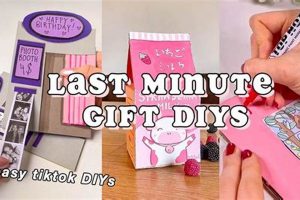The activity constitutes a method of encasing presents using kraft paper sacks fashioned by the gift-giver. The recipient receives the package in a container that the presenter has personally made or decorated.
This practice offers various advantages, including cost savings, personalization opportunities, and environmental benefits through the reuse of paper materials. Historically, resourceful individuals have employed readily available materials, such as paper bags, for packaging, reflecting a tradition of thrift and creativity. It allows the gift giver the flexibility to tailor the design to suit the recipient’s personality or the occasion, adding an extra layer of thoughtfulness to the present.
The subsequent sections will explore techniques for creating and embellishing these personalized containers, including material selection, folding methods, and decorative enhancements.
Enhancing Gift Presentation with Paper Sacks
Optimizing the appearance of gifts packaged in kraft paper requires attention to detail and a focus on clean, professional execution. The following tips provide guidance on achieving a polished aesthetic.
Tip 1: Select Appropriate Paper Stock: Choose a paper bag with sufficient thickness to prevent tearing and maintain its structure. Heavier weight paper presents a more premium feel.
Tip 2: Employ Precise Folding Techniques: Ensure folds are crisp and even for a symmetrical and visually appealing final product. Utilizing a bone folder can aid in achieving sharp creases.
Tip 3: Utilize High-Quality Adhesives: Employ glue sticks or double-sided tape designed for paper crafts to securely fasten seams and embellishments, preventing detachment.
Tip 4: Incorporate Minimalist Design Elements: Opt for simple embellishments, such as ribbon, twine, or strategically placed stickers, to avoid overwhelming the package.
Tip 5: Add Personalized Tags: Attach a professionally printed or neatly handwritten tag with the recipient’s name and a brief message for a personal touch.
Tip 6: Consider Color Coordination: Select paper sacks and decorative elements that complement the gift itself or adhere to a chosen color scheme for a cohesive presentation.
Tip 7: Implement Reinforcement Techniques: For heavier gifts, reinforce the bottom of the sack with cardboard or additional layers of paper to prevent structural failure.
Implementing these suggestions results in a finished product that reflects care and attention to detail, elevating the perceived value of the enclosed gift.
The concluding section will offer a summary of the key concepts and a final perspective on the benefits of this personalized packaging approach.
1. Sustainability
The convergence of “diy paper bag gift wrapping” and sustainability arises from the fundamental principle of resource conservation. The action of creating gift packaging from existing paper bags directly reduces reliance on newly manufactured materials, often derived from unsustainable forestry practices or fossil fuel-based production processes. By repurposing paper bags, individuals actively minimize waste destined for landfills or incineration, thereby mitigating environmental impact. Real-world examples include the utilization of grocery store paper bags, shopping bags from retail outlets, or even discarded newspaper sections as the base material for gift wrap. The importance of sustainability as a component is underscored by the growing awareness of ecological responsibility, prompting consumers to seek alternatives to conventional, single-use packaging that contributes significantly to pollution and resource depletion.
Further analysis reveals practical applications in diverse settings. Businesses can adopt “diy paper bag gift wrapping” as a sustainable alternative for packaging customer purchases, reinforcing a commitment to environmental stewardship. Educational institutions can integrate it into art and craft programs, teaching students about resourcefulness and ecological consciousness. Private individuals can extend the practice beyond gift-giving to other forms of packaging and storage, reducing their overall environmental footprint. For example, using brown paper bags and then painting them allows you to be creative and give gifts in a way that looks great.
In summary, “diy paper bag gift wrapping” serves as a tangible embodiment of sustainable practices, addressing the challenge of excessive packaging waste and promoting a more responsible approach to resource utilization. It links to the broader theme of environmental conservation, offering a practical and accessible means for individuals and organizations to contribute to a more sustainable future. This approach requires, however, continuous awareness and education regarding the broader life cycle of paper products and the responsible sourcing of materials to truly maximize environmental benefits.
2. Personalization
The intersection of personalization and the activity of creating gift containers from paper bags arises from the opportunity to tailor the presentation directly to the recipient’s identity and preferences. The direct consequence of employing this approach is the transmission of a message that transcends the gift itself, communicating care and attentiveness to the individual’s tastes and inclinations. This facet represents a pivotal element within “diy paper bag gift wrapping” as it elevates the act of giving beyond mere obligation to an expression of individual consideration. Examples manifest in the form of hand-drawn designs reflecting the recipient’s hobbies, selection of colors aligning with their personal aesthetic, or the inclusion of thematic elements pertinent to their interests or affiliations. The significance of this is that it shifts the focus from the monetary value of the gift to the emotional value of the gesture.
Further analysis reveals practical applications of this concept across various contexts. For family members, the containers can incorporate inside jokes or sentimental imagery. For professional colleagues, the design can subtly allude to shared work experiences or achievements. Artisanal producers can utilize this method to reinforce brand identity by employing consistent design motifs and branding elements. Educators can promote creativity by encouraging students to design wrappings that reflect the subject matter of the gift or the educational unit. The result is a tangible manifestation of the giver’s understanding and appreciation of the receiver, strengthening interpersonal connections and fostering positive relationships.
In summary, personalization acts as a key motivator and outcome, reinforcing the unique characteristics of the method. The approach faces the challenge of requiring effort, time, and a genuine understanding of the recipient. The overall concept links to broader societal trends towards individualized experiences and curated consumer goods, reflecting a growing desire for products and practices that resonate with personal identity and values.
3. Cost-effectiveness
The economic advantage inherent in creating gift packaging from paper bags is a significant factor for many individuals and organizations. The utilization of readily available materials and the elimination of commercial packaging purchases contribute to substantial cost reductions. The inherent cost savings position this method as a viable alternative to expensive store-bought wrappings.
- Reduced Material Expenditures
The primary cost saving derives from the use of pre-existing paper bags. Recycling shopping bags, newspaper, or kraft paper eliminates the need to purchase wrapping paper, ribbons, and other embellishments. For example, families with multiple gift-giving occasions annually can realize considerable savings by employing this approach instead of purchasing new wrapping paper each time. The reduction in material expenses is immediate and directly quantifiable.
- Minimized Waste Disposal Fees
By repurposing existing paper products, this method contributes to a reduction in waste volume. Municipal waste disposal services often charge fees based on the volume of waste generated. Reducing the amount of discarded wrapping paper consequently lowers waste disposal costs for households and businesses. For instance, a small business adopting this approach for customer orders can lower its monthly waste disposal bill.
- Lower Storage Requirements
Conventional wrapping paper and associated embellishments often require dedicated storage space. The bulk of rolls, ribbons, and bows necessitates storage containers and closet space. The “diy paper bag gift wrapping” method minimizes these storage requirements as the base materials are typically readily available and do not require extensive storage. This reduction in storage needs translates to indirect cost savings related to space utilization.
- Potential Tax Benefits for Businesses
Businesses adopting sustainable packaging practices may be eligible for tax deductions or incentives related to environmental stewardship. The use of recycled or repurposed materials can qualify businesses for these benefits, further enhancing the cost-effectiveness of this method. Consultations with tax professionals are necessary to determine eligibility and applicability within specific jurisdictions.
In conclusion, the economic advantages of “diy paper bag gift wrapping” extend beyond the mere reduction in material costs. The combined impact of lowered waste disposal fees, reduced storage needs, and potential tax benefits contribute to a comprehensive cost-effective solution for gift presentation. The total cost savings depend on the frequency of gift-giving and the scale of adoption, but the potential for financial benefit is demonstrably evident.
4. Material Versatility
The inherent adaptability of paper bag materials forms a cornerstone of “diy paper bag gift wrapping,” allowing for diverse aesthetic outcomes and functional adaptations based on the available resources and the giver’s creative intent. The following details elucidate the facets of this adaptability.
- Varying Paper Weights and Textures
Paper bags are available in a spectrum of thicknesses, from thin kraft paper suitable for lightweight gifts to heavier-gauge materials capable of supporting more substantial items. The texture can range from smooth, coated surfaces to rough, fibrous finishes, each lending a distinct visual and tactile quality to the finished product. For example, using a thick, textured paper bag for a handcrafted item enhances the rustic aesthetic, while a smooth, coated bag might be preferred for a more refined presentation. The choice directly influences the perceived quality and appropriateness of the packaging.
- Adaptability to Decorative Techniques
The surface of a paper bag readily accepts a wide array of embellishment techniques. It can be painted, stamped, stenciled, or adorned with applied materials such as ribbons, twine, and paper cutouts. The compatibility with diverse media enables the creation of highly personalized and thematic designs. A child’s birthday gift might be decorated with hand-painted characters, while a corporate gift could feature stamped logos and branded colors. This adaptability permits a high degree of creative control.
- Structural Modification Capabilities
Paper bags can be readily modified in terms of shape and size to accommodate various gift dimensions. They can be folded, cut, and reshaped to create custom enclosures. For example, a tall, narrow bag can be adapted to fit a bottle of wine, or a wide bag can be folded down to create a smaller pouch for jewelry. This structural flexibility reduces waste by eliminating the need for multiple sizes of pre-made wrapping paper.
- Integration with Complementary Materials
Paper bags seamlessly integrate with other materials to enhance both their aesthetic appeal and functional properties. Reinforcement with cardboard inserts can provide added stability for heavier gifts. The addition of fabric linings can protect delicate items from damage. The use of natural elements, such as dried flowers or leaves, can add a touch of organic elegance. This integrative capacity expands the range of design possibilities and enhances the overall presentation.
The preceding facets of material versatility highlight its pivotal role in the appeal of “diy paper bag gift wrapping.” By leveraging the inherent adaptability of paper bags, individuals can achieve personalized, aesthetically pleasing, and functionally appropriate packaging solutions. This approach encourages resourcefulness and promotes a more sustainable approach to gift-giving.
5. Creative expression
Creative expression functions as a primary driver in the adaptation of paper bags for gift presentation. This activity offers a tangible outlet for individual artistic inclinations, transforming a commonplace item into a medium for personalized communication. The cause-and-effect relationship is direct: the desire for personalized gift-giving stimulates creative expression, leading to unique and individualized packaging solutions. Creative expression is not merely an aesthetic addendum but an integral component, differentiating handcrafted packaging from mass-produced alternatives. Examples include the application of intricate hand-painted designs, the incorporation of mixed-media collage elements, or the utilization of advanced paper-cutting techniques to create bespoke patterns. This focus enhances the emotional impact of the gift itself.
Further analysis reveals practical applications across various demographics and scenarios. Educators can utilize this activity as a platform for art instruction, fostering creativity and resourcefulness in students. Small business owners can employ it to reinforce brand identity by creating distinctive packaging that reflects their unique values. Individuals can personalize gifts for family and friends by incorporating elements that resonate with the recipient’s personal interests and preferences. For instance, a gift for a musician could be wrapped in a paper bag adorned with musical notes and instrument illustrations. The practical result is an enhanced sense of connection and appreciation.
In summary, the connection between creative expression and this activity transcends mere decoration; it represents a deliberate effort to imbue the gift-giving process with personal meaning and artistic value. While the challenge lies in dedicating the time and effort required to create truly unique designs, the potential rewards in terms of enhanced emotional impact and strengthened interpersonal relationships are substantial. This links to the broader theme of valuing handcrafted items and personalized experiences in a world increasingly dominated by mass production.
Frequently Asked Questions
The following addresses common inquiries regarding the technique of encasing presents using kraft paper sacks created by the giver. These are aimed at clarifying practical aspects and addressing potential concerns.
Question 1: What types of paper bags are most suitable for gift wrapping?
Kraft paper bags, both brown and colored, are generally recommended due to their durability and versatility. Bags from grocery stores, retail outlets, or even unused shipping bags can be repurposed. Glossy or heavily printed bags may be less suitable as the print can interfere with decorative embellishments.
Question 2: How can the structural integrity of a paper bag be improved for heavier gifts?
Reinforcement of the bag’s base is crucial for heavier items. A piece of cardboard cut to fit the bottom of the bag provides added support. Alternatively, multiple layers of paper can be glued to the inside of the bag’s base to increase its strength. Securing handles or adding additional support straps can also improve weight distribution.
Question 3: What adhesives are recommended for securing seams and embellishments on paper bags?
Glue sticks designed for paper crafts are suitable for general adhesion. Double-sided tape provides a clean and secure bond for seams and smaller embellishments. For heavier or more permanent attachments, a hot glue gun can be used with caution. Ensuring the adhesive is acid-free prevents discoloration or damage to the paper over time.
Question 4: How can the aesthetic appeal of a paper bag be enhanced without extensive artistic skills?
Simple, minimalist designs can be highly effective. The use of patterned ribbon, twine, or washi tape can add visual interest without requiring advanced artistic skills. Stencils or stamps can also be used to create repeating patterns or thematic designs. Personalized tags with neat handwriting or simple typography can further enhance the presentation.
Question 5: How can paper bags be adapted to accommodate irregularly shaped gifts?
The bag can be modified by cutting and folding the excess paper to create a custom fit. For particularly awkward shapes, consider creating a paper bag “envelope” by folding the bag flat and securing the sides with tape or glue. Tissue paper can be used to fill empty spaces and provide cushioning.
Question 6: Is it possible to achieve a professional-looking finish with paper bag gift wrapping?
Yes, with attention to detail. Crisp, clean folds, precise adhesive application, and thoughtful embellishment contribute to a polished appearance. Avoid excessive decoration, opting instead for simple, elegant designs. Practice and experimentation will refine the technique and improve the final result.
In summary, creating personalized containers with paper is a method that can be cost-effective and creative. With careful technique and attention to detail, one can transform an ordinary paper bag into something special.
This information provides a foundation for understanding and implementing this approach. Further resources and tutorials are readily available for additional inspiration and instruction.
Conclusion
The preceding sections have explored the multi-faceted nature of diy paper bag gift wrapping. It is, in essence, a practice encompassing sustainability, personalization, cost-effectiveness, material versatility, and creative expression. The analysis demonstrates its potential as an alternative to conventional packaging methods, highlighting both its benefits and practical considerations. These elements combine to form a unique approach, requiring both resourcefulness and attention to detail.
The continued exploration of diy paper bag gift wrapping, combined with responsible sourcing and conscious application, contributes to minimizing environmental impact and can maximize both economic and aesthetic value in gift presentation. Further efforts aimed at refining techniques and disseminating best practices will determine the continued relevance of this method in the future.







